There's no point in ignoring the challenges in moving to nuclear powered boats, but equally there's not much point in exaggerating them either, or ignoring the benefits of that change.This is an excellent video about the challenges that Australia has (will have) when it embarks on its journey towards the purchase of a nuclear powered submarine. This video also provides a good idea of what obstacles Canada will also face if it ever decides to buy nuclear powered submarines to replace the Victoria Class. Probably the two major differences are that: (1) unlike Australia, Canada already has substantial nuclear power expertise; and (2) Canada will most likely not build nuclear powered submarines.
On the big hand, the Australian plan is as follows:
Phase 1. Training with US and UK submariners
Phase 2. Receiving Virginia Class submarines in the 2030s
Phase 3. First AUKUS designed submarine will delivered in the 2050s.
Challenges:
1. Building up the number of the submariners to accommodate the nuclear submarines. Need 3,000 trained pers.
2. Infrastructure for the new fleet
3. Cost. $368B or $32M/per for 30 yrs will mean the other Services (Army, Air Force, surface Navy) will suffer cuts. Degradation of overall defence capability and capacity to react?
4. Build up of technical expertise, especially trained engineers, for this program.
5. Significant risk in acceptance and building of a newly designed nuclear powered submarine
6. Significant risk of the Collins Class submarines aging out before 2030s plus the need for $6B to maintain them up to the 2030s.
In brief: Unlike Canada, Australia has big balls to do this despite the challenges and risks.
Sustaining and upgrading a small, six-strong, fleet of unique diesel electric subs that share only their combat system and primary weapons with the USN, is not a simple or inexpensive task either. The ability to tap into the Virginia / AUKUS support and sustainment programs should be a significant advantage.
I'm not sure a nuclear power industry is a necessary training ground for expertise as apposed to Australia's current research reactor program. Either way, operating reactors at sea, under water, is a very different operating environment.
Last edited:


:quality(70)/cloudfront-us-east-1.images.arcpublishing.com/archetype/UEXPVJFWPRAWZE2PABOZNQ3BBI.jpg)



